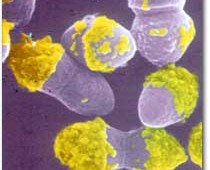WALNUT CREEK, CA — In their continuing search for new clues to how human genes function and how vertebrates develop and evolve, researchers at the U.S. Department of Energy’s Joint Genome Institute (JGI) are gearing up to map the DNA of a diminutive, fast-growing African frog named Xenopus tropicalis. Frogs have long been a favorite…
Pufferfish DNA Yields Clues to Human Biology
An international research consortium led by the U.S. Department of Energy’s Joint Genome Institute (JGI) reported today on the draft sequencing, assembly, and analysis of the genome of the Japanese pufferfish Fugu rubripes. The report was released on Science Magazine’s Science Express Web site. Pufferfish have the smallest known genomes among vertebrates, the group of…
A First Line of Defense Against Disease Organisms
WALNUT CREEK, CA — The Department of Energy’s Joint Genome Institute (JGI), whose Production Genomics Facility in Walnut Creek is one of the fastest and most powerful in the U.S., has been enlisted to help safeguard public safety by determining the whole genome sequences of a variety of infectious bacteria–a first step toward developing tests…
Department of Energy Solicits Recommendations for Microbial Sequencing Targets
The U.S. Department of Energy (DOE) is seeking nominations of microbes and microbial communities as candidates for draft genomic sequencing in support of its Microbial Genome and the Genomes to Life Programs. Candidate microbes and microbial communities should be relevant to DOE mission needs, e.g., microbes involved in environmental processes, waste remediation, carbon management, energy…
Gene-Rich Pufferfish DNA Decoded
An international research consortium has taken a substantial short cut to the biologically important information embedded in the human genome with the completion of a draft sequence of the genome of the Japanese pufferfish Fugu rubripes. The Fugu draft sequence will be announced at the 13th International Genome Sequencing and Analysis Conference in San Diego,…
Joint Genome Institute Facility’s New Name Shows Changing Mission
The Joint Genome Institute’s Walnut Creek facility has been given a new name. The name change – to the Production Genomics Facility from the Production Sequencing Facility – reflects a shift in focus and its changing scientific environment, according to JGI Director Trevor Hawkins. Since the JGI was established in 1997, combining the gene-sequencing efforts…
Trevor Hawkins is Appointed Director of Joint Genome Institute
The three University of California laboratories that manage the Department of Energy Joint Genome Institute (JGI), Los Alamos National Laboratory, Lawrence Livermore National Laboratory and Lawrence Berkeley National Laboratory, announced on November 3rd the appointment of Dr. Trevor Hawkins as Director of the JGI. Dr. Hawkins replaces Dr. Elbert Branscomb who will assume a leadership…
Consortium to Sequence Fugu Fish: Potential Boon for Gene Hunters
by Lynn Yarris BERKELEY, CA — Scientists searching the human genome data for genes and the DNA sequences that control their activity will soon have a valuable new resource, courtesy of the Japanese delicacy known as fugu (Fugu rubripes), the puffer fish. An international consortium, led by researchers at the Joint Genome Institute (JGI) of…
International Human Genome Sequencing Consortium Announces “Working Draft” of Human Genome
The Human Genome Project public consortium today announced that it has assembled a working draft of the sequence of the human genome–the genetic blueprint for a human being. This major milestone involved two tasks: placing large fragments of DNA in the proper order to cover all of the human chromosomes, and determining the DNA sequence…
JGI Sequences “Supergerm” Genome in One Day
Only three weeks ago the Department of Energy’s Joint Genome Institute announced completion of the working draft covering human chromosomes 5, 16 and 19. Today, JGI Deputy Director Trevor Hawkins was able to highlight a new milestone. In collaboration with Drs. Barbara Murray (UofT Houston Med. School) and George Weinstock (Baylor College of Medicine), the…

